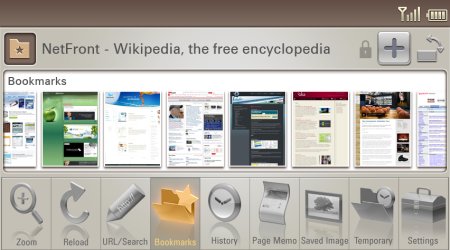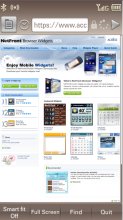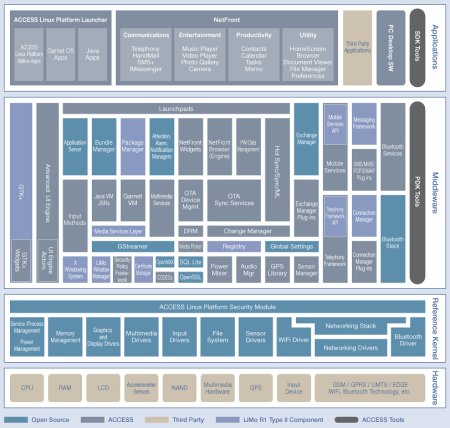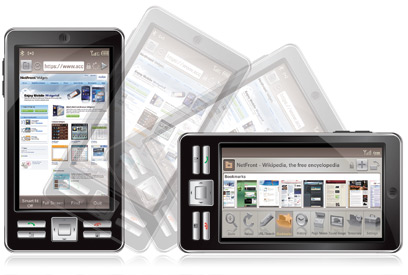LiMo-ready Linux stack goes 3D
Feb 17, 2009 — by Eric Brown — from the LinuxDevices Archive — 5 views Access is demonstrating its Access Linux Platform (ALP) 3.0 at Mobile World Congress in Barcelona. The new LiMo-compatible “advanced UI” mobile ALP stack leverages Open GL-ES 2.0 to offer 3D special effects, and introduces a standardized API that splits logic from presentation layers, says Access.
Access is demonstrating its Access Linux Platform (ALP) 3.0 at Mobile World Congress in Barcelona. The new LiMo-compatible “advanced UI” mobile ALP stack leverages Open GL-ES 2.0 to offer 3D special effects, and introduces a standardized API that splits logic from presentation layers, says Access.
(Click for larger view of ALP 3.0 home screen interface)
First demonstrated in October, ALP 3.0 is said to be “available soon.” The new mobile stack is apparently sufficiently complete to have formed the basis of a reference design for the new R2 generation of the LiMo Platform, says the Japanese software company. As reported earlier, Access is one of five LiMo members to contribute reference designs for the R2 release. Its design is said to be an ALP 3.0 subset, and one of two R2 “Reference Implementations.”

ALP 3.0's NetFront Browser in landscape mode
(Click to enlarge)
Access has said that NTT DoCoMo will distribute ALP 3.0 in LiMo-compliant phones from NEC and/or Panasonic that will be released this year. Meanwhile, Azingo, the developer of the other major LiMo smartphone reference design, has signed up Vodafone to release a smartphone based on its new Azingo Mobile 2.0 stack. (A third LiMo reference design, from Purple Labs, targets lower-end feature phones, and has yet to be revealed, perhaps because the company is in the process of merging with Esmertec to form Myriad Group.)



ALP 3.0 screens
(Click any to enlarge)
ALP is now offered in two versions: ALP for Smartphones and ALP for Mobile Internet Devices. At the Mobile World Congress this week in Barcelona, Access is demonstrating ALP 3.0 running on Texas Instruments's ARM Cortex-A8-based Zoom OMAP34x-II Mobile Development Platform.
Although aimed primarily at ARM Cortex devices, both 3.0 versions target a baseline platform of a 400MHz ARM9-based processor, says Access. Another suggested capability is hardware 3D acceleration, to support ALP's OpenGL-ES 2.0 capabilities. ALP 3.0 also looks for at least 128MB of RAM, and 128MB of flash, and targets a range of resolutions between 240 x 320 and 800 x 480. (Access also offers an “ALP Mini” stack targeting lower-end feature phones, and which is slated for use in a reference design created with NEC for a 3G-enabled handset based on NEC's ARM9-based MP201 application processor.)

 “>
“>
More ALP 3.0 screens
(Click any to enlarge)
OpenGL-ES 2.0 adds some dazzle
ALP 3.0 offers an advanced UI engine and middleware, as well as new support for support for 2.5D and 3D graphics environments that enable the development of “Hollywood-style graphics and transition effects,” says Access. The mobile stack also improves the ability of different applications from different environments to be concurrently executed, says the company. In particular, it is said to be easier to render content, including contacts, appointments, videos, and or photos, in multiple screens and applications.
“Access Linux Platform 3.0 offers an advanced UI, and it has been given the seal of approval for LiMo compliance,” said Didier Diaz, SVP product strategy at Access, in an interview. In addition, he said that a standardized API now enables ALP developers to modify an application's look and feel without changing its code. “For the first time, we differentiate between the logic and the presentation layers, which makes it easier to alter the look and feel, and we have also improved 3D graphics, animations, and effects like transparency, translucency, mirroring, and shading.”

ALP 3.0 architecture
(Click to enlarge)
A full list of ALP 3.0 features can be found in a link at the end of this story. Here are the major features in each of the main categories:
- Telephony and communications — Speed dial, multi-party conferencing, “multihoming,” GPS/A-GPS support, and support for IMPS, SMS, MMS, Cell Broadcast, IMAP4, and POP3
- Input and navigation — Support for 12-key keypad, stylus, or finger touchscreen input, plus accelerometer and presence detection support
- User data and software management — PIM features and synchronization, with Microsoft Outlook interoperability, backup and restore with desktop, OMA and OMA FOTA updates
- Advanced UI engine — Server-based graphics rendering, support for 2.5D and 3D graphical environments, and hardware accelerated OpenGL-ES 2
- Media framework components — MP3, AMR-NB, AMR-WB, AAC, MIDI, MPEG4-SP, H.263, H.264, WMA/WMV v9, plus OMA DRM 1.0
- Language, security, etc. — Multiple languages supported, plus an OMTP security policy framework, and a VPN framework
- Wireless and connectivity protocols — 3G radios, TCP/IP, WiFi 802.11b/g, WPA2, WEP, Roaming, Bluetooth 2.0, USB, IrDA, serial
Above this ALP middleware, the stack includes multiple NetFront-branded user applications, including:
- Communications — Phone, HandMail, SMS+, SIM Application Toolkit, iMessenger
- PIM — Contacts, Calendar, Memos, Tasks
- Multimedia — Music, Videos, Photos, Camera
- Productivity — Home Screen (Includes NetFront Widgets player), HotSync Manager, Browser, Document Viewer
- Utilities — Clock, Calculator, Recorder, File Manager

ALP 3.0 supports landscape/portrait accelerometer tilt response
ALP SDK includes simulator
The ALP 3.0 software development kit (SDK) is said to include an Eclipse IDE (integrated development environment), enabling the development of native applications for LiMo-compliant devices. The Linux-based SDK allows users to create user interfaces with GUI builder tools, and it includes a “Virtual Phone” simulator for testing, says Access.
Supported application development environments include native development with GTK+ and the Hiker Application Framework (HAF), says the company. There is also said to be support for Garnet VM apps, as well as the integration of NetFront Widgets content written with HTML, CSS, and JavaScript.
Access looking to escape the island
According to Diaz, there is considerable interest in LiMo among its Japanese partners, including NTT DoCoMo, because it is a seen as a way for Japanese mobile technologies to expand beyond the unique Japanese market. “The Japanese mobile market has specific challenges in that its services and devices are so unique,” said Diaz. “That makes it difficult for the Japanese ecosystem to play on the global stage. The need to expand globally is part of the driving force of LiMo compliance in Japan.”
In Barcelona, Access also announced that as of the end of January there have been over 700 million deployments of its Linux-compatible NetFront products, principally its NetFront Browser for mobile handsets and Internet-enabled devices. The company pegged recent growth for Netfront to the popularity of its new NetFront Widgets technology available with the browser. The company also said it is in the process of adding support for the Open Mobile Terminal Platform (OMTP) BONDI standard, which was recently adopted by the LiMo Foundation for R2.
The company also announced new members of its Access Connect Ecosystem (ACE). The new business partners include AccuWeather, Mapbar, Oki Electric, Postal & Telecommunications Entel Technology (PTET), and STMicroelectronics. Access recently announced a management shuffle, including naming a new CEO for the Access America unit that is responsible for ALP.
Stated Tomihisa Kamada, newly named Co-CEO and president of Access, “The flexibility, modularity and openness of Linux make it ideal for mobile operators to deliver customized services — and our ACCESS Linux Platform v3.0 and ACCESS Linux Platform mini products make this customization easy to develop and market to consumers.”
Stated Akshay Agarwal, worldwide ecosystem partner manager at Texas Instruments, “The ACCESS Linux Platform is a complete framework with a UI that can be easily customized to support a wide range of devices from smart phones to Mobile Internet Devices. The power of the OMAP 3 processor combined with the ACCESS Linux Platform allows handset manufacturers to get to market quickly with handsets that have a unique look and feel.”
Availability
Access Linux Platform (ALP) 3.0 will be available soon, says Access. The company is demonstrating the technology at its booth at Mobile World Congress this week in the Courtyard Area CY10, Fira de Barcelona. More information may be found here.
This article was originally published on LinuxDevices.com and has been donated to the open source community by QuinStreet Inc. Please visit LinuxToday.com for up-to-date news and articles about Linux and open source.